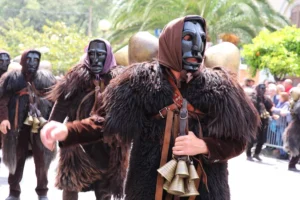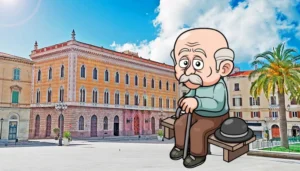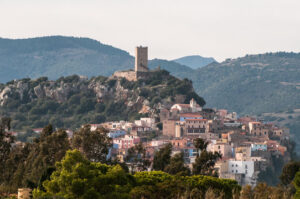Table of Contents
What are the Nuraghe Of Sardinia? Tracing the Meandering Paths of these Megalithic Edifices
As we journey through the enchanting landscapes of Sardinia, our eyes are drawn to the unique architectural wonders scattered across the island. These ancient structures, known as Nuraghe, stand as silent sentinels of Sardinia’s rich past, their imposing forms casting long shadows over the surrounding countryside. As we delve into the tale of these megalithic edifices, we can’t help but marvel at the craftsmanship and ingenuity of the Nuragic civilization, a pre-Roman culture that left an indelible mark on the island’s cultural and architectural landscape.
The Nuragic Enigma: What is a Nuraghe?
The Nuraghe, unique to Sardinia, are ancient megalithic edifices that bear testament to the island’s Nuragic civilization. These structures, developed during the Bronze Age between 1900 and 730 B.C., are a remarkable display of the architectural prowess of the Nuragic people. Today, these structures serve as the emblem of Sardinia and its distinctive culture.
Although more than 7,000 Nuraghe have been discovered, archaeologists believe there were originally more than 10,000 Nuraghe scattered across the island. These megalithic monuments range in complexity from simple, single tower forms to intricate, multi-tower complexes, reflecting the evolution of architectural styles over time.
Megalithic Edifices of the Nuragic Civilization

The Enigma of Nuraghe Etymology
The name ‘Nuraghe’ is as fascinating as the structures themselves. In the native Sardinian language, the structure is referred to as a nurhage or nuraxi. The term is presumed to be related to Sardinian place names like Nurra , Nurri , and Nurru. However, the exact origins of the term remain shrouded in mystery, with several theories suggesting connections with the Semitic base of Arabic n ūr ‘light, fire’, the Latin word murus (‘wall’) or the Proto-Basque term *nur (stone).
Read our article on the Giants of Mont’e Prama
The Architectural Marvels of the Nuragic Age
The Nuragic Age, stretching from 1800 BC until 500BC, was a period of remarkable architectural development. The Nuraghe are frequently found on hilltops, offering strategic vantage points. These structures offer a glimpse into the multifunctional nature of ancient architecture, serving as homes, fortresses, temples, or meeting halls.
The Nuraghe flaunt a variety of internal layouts, often featuring a spiral staircase leading to the top of the tower. Excavations at these sites reveal evidence of domestic life, including stone tools and animal bones, suggesting that the Nuraghe were not only strategic fortresses but also dwelling places where people lived, stored food, and stayed warm.
The Purpose of the Nuraghe: A Multifunctional Marvel
The Nuraghe served multiple purposes, reflecting the versatile nature of ancient architecture. They were often constructed in strategic locations, offering panoramic views of the surrounding landscape. Some scholars suggest that there could be thousands of Nuraghe hidden beneath the soil, yet to be discovered.
The internal layouts of these structures imply varied uses. For instance, a spiral staircase leading to the top of the tower would offer an excellent vantage point to spot potential threats, indicating a defensive or lookout function. The presence of stone tools and animal bones suggests that the Nuraghe also served as living quarters. The structures’ versatility makes it challenging to pinpoint their exact purpose, but it is evident that they were multifunctional, adaptable to the changing needs of the Nuragic people.
The Mysterious Nuragic Civilization: A Journey Through Time
The Nuragic civilization, the creators of these magnificent structures, remains one of the most enigmatic ancient cultures. Little is known about this civilization, and all that remains of their existence are the Nuraghe and exquisite bronze figurines. The only written records about the Nuragic civilization come from ancient Greek and Roman sources, leaving us with a web of myths and legends.

The Nuraghe: A Symbol of the Nuragic Civilization
The Nuraghe are often considered as the ‘national’ symbol of the Nuragic civilization. Some theories suggest that they were status symbols or passive defence structures, serving as deterrents for potential enemies. Others argue that the Nuraghe were the physical manifestation of the civilization’s territorial claims, indicating the presence of its owners. Regardless of their exact purpose, the Nuraghe are a fascinating testament to the architectural and cultural prowess of the Nuragic civilization.
Nuraghe: Types and Variations
Nuraghe come in various forms, reflecting the evolution of architectural styles over time. The most archaic type is the Protonuraghe, characterized by their stocky appearance and irregular plan.
The Mixed Nuraghe are thought to be a later development, incorporating modifications to the original Protonuraghe design.
The Single-tower Nuraghe, with their truncated conical shape, are the most common type of Nuraghe. These structures often feature a central room, accessible through a passageway, and a spiral stone stair built within the thick walls.
The Tancadu Nuraghe represent a further evolution of the Nuraghe design, featuring an additional circular building attached to the main tower and connected by enclosing walls.
The most elaborate of all Nuraghe are the Polylobed Nuraghe, also known as Nuragic royal palaces. These structures resemble fortresses, with multiple towers connected by high ramparts.
Notable Nuraghe: The Sardinian Nuraghe Most Worth Seeing!
While all Nuraghe are of significant historical and cultural interest, certain structures stand out for their architectural complexity and state of preservation.
- Su Nuraxi di Barumini, located in the south of Sardinia, is one of the most famous Nuraghe. This complex Nuraghe is surrounded by a large ancient village and has been designated a UNESCO World Heritage Site.
- Nuraghe Santu Antine, situated near the village of Torralba in northern Sardinia, is one of the tallest and most complex Nuraghe.
- Nuraghe Palmavera, near Alghero, is another must-visit Nuraghe, boasting a central tower surrounded by more than 50 huts.
- The Nuraghe Arrubiu, located in Orroli, is a fascinating Nuraghe complex highlighted by its basalt constructions covered in reddish lichen.
- The Nuraghe Losa, near Abbasanta, features a unique triangular design, resembling the bow of a ship.

Nuraghe: The Legacy of a Lost Civilization
The Nuraghe of Sardinia illuminate the pages of history, offering a glimpse into a long-lost civilization. These structures, with their distinctive architecture and strategic locations, encapsulate the essence of the Nuragic civilization – a culture that thrived in the Bronze Age and left an indelible mark on Sardinia’s cultural heritage.
As we wander through the Nuraghe, we can’t help but feel a sense of awe and wonder at the architectural prowess and ingenuity of the Nuragic people. The Nuraghe, with their silent, towering presence, serve as a timeless reminder of Sardinia’s rich history and the enduring legacy of the Nuragic civilization.
Exploring the Nuraghe: An Unforgettable Journey Back in Time
A visit to the Nuraghe offers an unforgettable journey back in time, transporting us to a bygone era of ancient civilizations and architectural marvels. As we walk through these ancient structures, we are immersed in the rich tapestry of Sardinia’s past, gaining a deeper understanding of the island’s cultural heritage and the remarkable achievements of the Nuragic civilization.
Whether you’re a history enthusiast, an architecture lover, or simply a curious explorer, a visit to the Nuraghe of Sardinia is a must-do experience that promises to captivate and inspire. So, on your next trip to Sardinia, don’t miss the chance to step back in time and explore these fascinating megalithic edifices – the enduring legacy of the Nuragic civilization.

Conclusion: The Enduring Allure of Sardinia’s Nuraghe
Sardinia’s Nuraghe stand as enduring testimonies to the island’s rich history and cultural heritage. These ancient structures, with their distinctive architecture and strategic locations, offer a fascinating insight into the Nuragic civilization, a culture that thrived during the Bronze Age and left an indelible mark on Sardinia’s cultural landscape.
Whether you’re a history buff, an architecture enthusiast, or simply a curious traveller, a visit to the Nuraghe is a must-do experience when in Sardinia. As you explore these ancient structures, you’ll be transported back in time, immersing yourself in the rich tapestry of Sardinia’s past and marvelling at the architectural prowess and ingenuity of the Nuragic people.
So, on your next trip to Sardinia, don’t miss the chance to step back in time and explore these fascinating megalithic edifices – a journey that promises to captivate and inspire.








